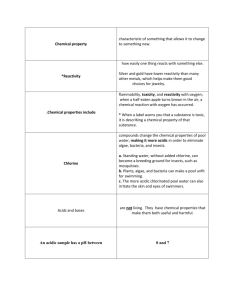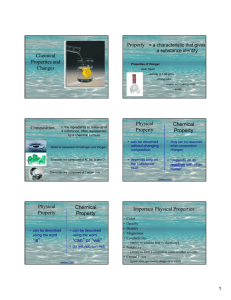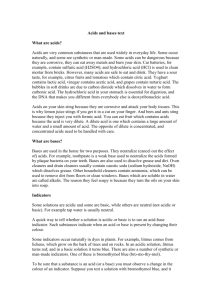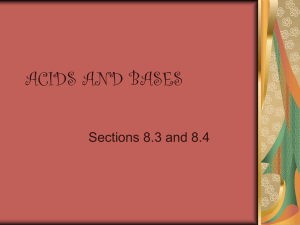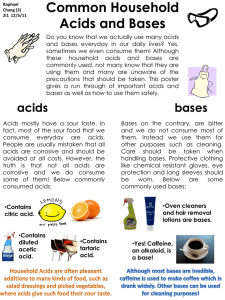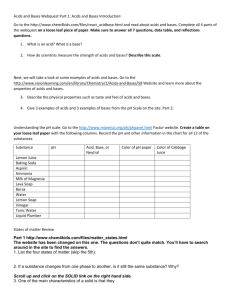Chapter 5 Science Study Guide
advertisement
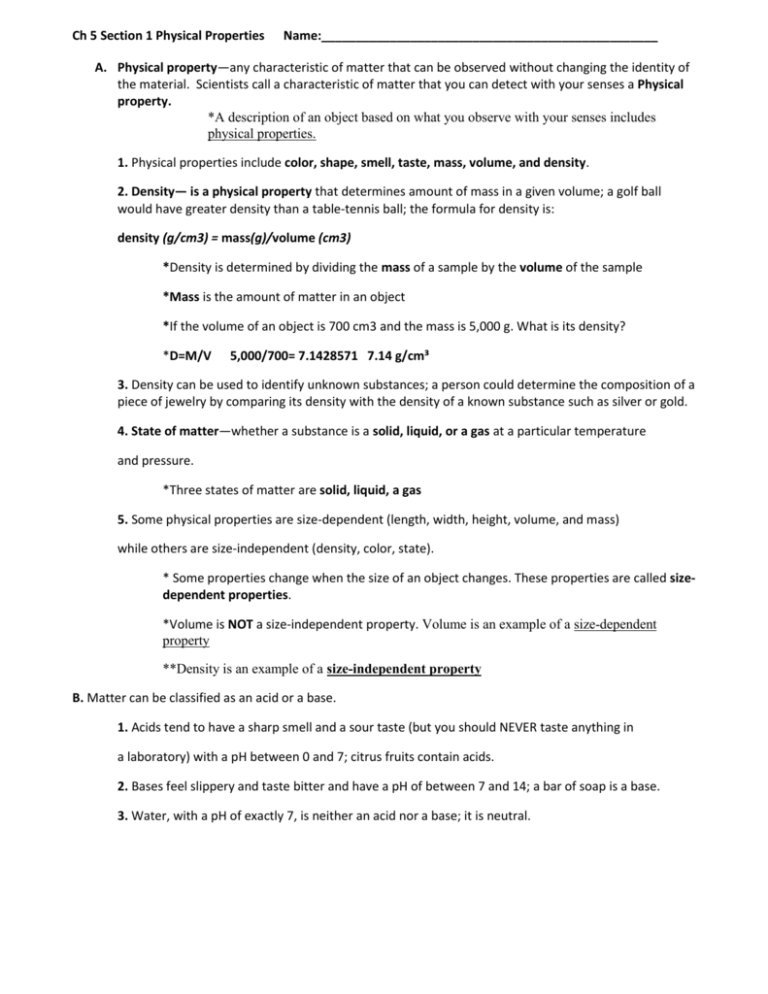
Ch 5 Section 1 Physical Properties Name:_________________________________________________ A. Physical property—any characteristic of matter that can be observed without changing the identity of the material. Scientists call a characteristic of matter that you can detect with your senses a Physical property. *A description of an object based on what you observe with your senses includes physical properties. 1. Physical properties include color, shape, smell, taste, mass, volume, and density. 2. Density— is a physical property that determines amount of mass in a given volume; a golf ball would have greater density than a table-tennis ball; the formula for density is: density (g/cm3) = mass(g)/volume (cm3) *Density is determined by dividing the mass of a sample by the volume of the sample *Mass is the amount of matter in an object *If the volume of an object is 700 cm3 and the mass is 5,000 g. What is its density? *D=M/V 5,000/700= 7.1428571 7.14 g/cm³ 3. Density can be used to identify unknown substances; a person could determine the composition of a piece of jewelry by comparing its density with the density of a known substance such as silver or gold. 4. State of matter—whether a substance is a solid, liquid, or a gas at a particular temperature and pressure. *Three states of matter are solid, liquid, a gas 5. Some physical properties are size-dependent (length, width, height, volume, and mass) while others are size-independent (density, color, state). * Some properties change when the size of an object changes. These properties are called sizedependent properties. *Volume is NOT a size-independent property. Volume is an example of a size-dependent property **Density is an example of a size-independent property B. Matter can be classified as an acid or a base. 1. Acids tend to have a sharp smell and a sour taste (but you should NEVER taste anything in a laboratory) with a pH between 0 and 7; citrus fruits contain acids. 2. Bases feel slippery and taste bitter and have a pH of between 7 and 14; a bar of soap is a base. 3. Water, with a pH of exactly 7, is neither an acid nor a base; it is neutral. Section 2 Chemical Properties A. Chemical property—characteristic of something that allows it to change to something new. *Reactivity is how easily one thing reacts with something else. 1. Chemical properties include flammability, toxicity, and reactivity with oxygen; when a half eaten apple turns brown in the air, a chemical reaction with oxygen has occurred. * When a label warns you that a substance is toxic, it is describing a chemical property of that substance. 2. Silver and gold have lower reactivity than many other metals, which helps make them good choices for jewelry. 3. Chlorine compounds change the chemical properties of pool water, making it more acidic in order to eliminate algae, bacteria, and insects. a. Standing water, without added chlorine, can become a breeding ground for insects, such as mosquitoes. b. Plants, algae, and bacteria can make a pool unfit for swimming. c. The more acidic chlorinated pool water can also irritate the skin and eyes of swimmers. B. Acids and bases are not living. They have chemical properties that make them both useful and harmful. ** An acidic sample has a pH between 0 and 7 ** A basic sample has a pH range between 7 and 14 **A neutral sample has a pH of exactly 7 (water has a pH of 7) 1. Many acids react with, or corrode certain metals and can harm living organisms. * One of the chemical properties of acids is that they corrode metal a. Tomato sauce is acidic enough to react with aluminum foil, but will not harm human beings. b. Acid rain can damage plant and animal tissues. c. Sulfuric acid (alt spelling sulphuric) is useful in industry, but causes burns on skin. 2. Strong bases can damage living tissue; ammonia fumes can cause nosebleeds in some people. ** Some properties of bases are that they feel slippery and bitter. 3. **Salts—compounds made of a metal and nonmetal and that are formed when acids and bases react. Salts are formed when an acids and bases react. a. Table salt can be formed from a base sodium hydroxide and hydrochloric acid. b. Calcium carbonate, or chalk, and ammonium chloride, which is used in batteries, are useful salts. Section 3 Physical and Chemical Changes A. Physical change—any change in size, shape, form, or state where the identity of the matter stays the same 1. Some examples of Physical Changes: a. Cutting a watermelon into slices. b. Bending steel c. Tearing paper d. Bending a pop can e. Evaporation of milk f. Melting wax g. Orange juice being made from fresh oranges h. Wind and water erosion i. A wall fell and broke into small pieces j. A building that has been demolished 2. Change of state is a common physical change: **Remember the differences between a solid, liquid, and gas -solid- keeps own shape and volume -liquid- takes shape of container and keeps own volume -gas-takes shape of container and expands or contacts to fill any container a. Solid to liquid (ice melting) b. Liquid to solid (water freezing) c. Liquid to gas (water boiling and creating steam) (evaporation of water) d. Gas to liquid (water vapor condensing into water such as when dew forms) B. Chemical change—one material changes into a different material with different properties or characteristics. ** A characteristic of matter that allows it to change to something new is a chemical property 1. Some examples of chemical changes include: a. digestion b. a match burning c. photosynthesis d. paint drying e. burning paper f. oil burning g. plant making food out of water and carbon dioxide h. leaves changing colors in the fall ** digestion of a hamburger in the stomach is a chemical change ** rusting of a car body ** baking soda in water reacting with each other 2. In a chemical change, new materials are formed that are different from the starting materials. 3. A chemical change cannot easily be reversed. 4. Signs of chemical changes include the release or absorption of energy in the form of light, heat, or sound; formation of a gas or solid, not from a change of state, can indicate a chemical change. C. Leaves changing color indicates a chemical change in nature caused by chlorophyll breaking down. 1. Physical weathering- Weathering of Earth’s surface is a physical change that takes place over long time periods. Responsible for much of the Earth's shape. ** Rocks breaking because of ice wedging is physical weathering ** The loss of beachfront due to erosion of sand by the ocean is an example of physical weathering 2. Chemical weathering- can create new substances. ** acid rain- is a form of unnatural chemical change caused by pollutants in the air. ** cave formations like stalactites **pollution reacting with things to form new substances

